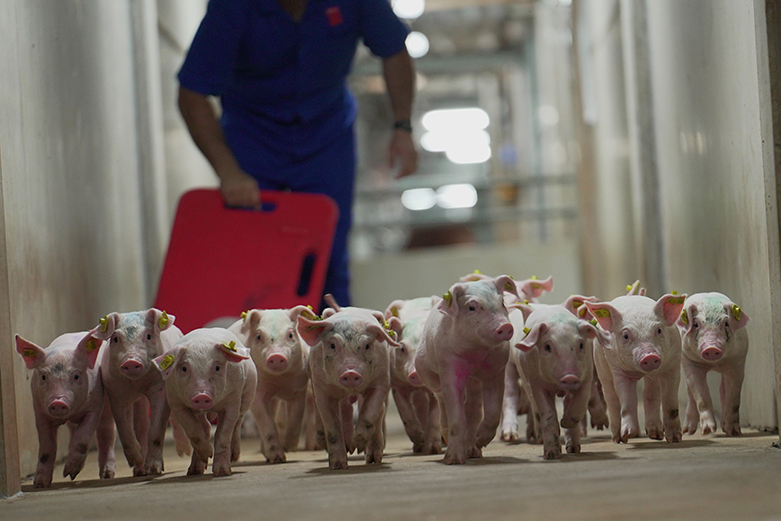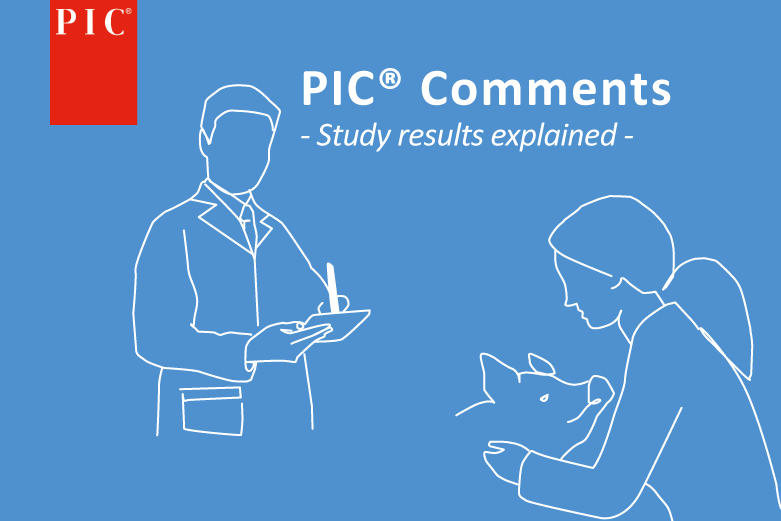Project “Litter of origin”
Decades of selection for increased litter size has resulted in a population of sows with an extreme low average litter birth weight phenotype (BWP), irrespective of litter size. The authors of this study hypothesize that this phenotype is the result of poor placental development driven by extreme intra-uterine crowding of embryos in early gestation and involves an interaction of hard to measure reproductive traits that are not responsive to current selection practices. However, measuring and managing this sow-dependent phenotype at production nucleus level would improve overall breeding herd efficiency and the number of quality weaned pigs per sow lifetime.
A project was designed to test this concept. In a multiplication herd producing Camborough® replacement gilt individual weights of 47,338 piglet were recorded in litters born in parities between one and seven. The birth weight phenotype of the sow was determined over at least two successive parities for litters with >9 total born. Sows (n = 651) were then classified as having a low, low-medium, medium-high, or high birth weight phenotype based on their successive litter records, see table 1. The overall average birthweight was 1.36 kg. Within 12 h after birth, born alive females (n = 7,552) received a unique ear ID tag and retention rate (RR) was determined from birth until pre-selection to enter the breeding herd (pre-pubertal gilts at 190 d of age) having applied the standardized selection criteria. The Retention Rate was analysed as a Chi square using the PROC FREQ procedure of SAS.
RR was significantly lower (P ≤ 0.05) for Low Birth Weight Phenotype of the sow than for Low-Medium, Medium-High and High BWP sows within 4 d after birth, at 24 d of age, at 70 d of age and at pre-selection, see table 2.
As has been reported for low individual pig birth weights, retention of gilts born to sows with the low BWP was compromised. Effects of a low BWP on final selection and on sow lifetime productivity will be determined. At the level of the production multiplication unit, the ability to predict a low BWP can be directed at strategic culling decisions and protocols for pre-weaning management of potential replacement gilts to improve retention in the gilt pool.
Table 1: Classification of sows determined by Litter Birth Weight Phenotype
| Category (no. of sows) | Weight range (kg) | % of litters | n piglets ear tagged |
|---|---|---|---|
| Low (L), n = 63 | < 1.15 | 9.7 | 607 |
| Medium-low (ML), n = 281 | ≥ 1.15 und ≤ 1.36 | 43.2 | 3,765 |
| Medium-high (MH), n = 254 | > 1.36 und ≤ 1.6 | 39.0 | 2,561 |
| High (H), n = 53 | > 1.6 | 8.1 | 619 |
Table. 2 Retention Rate (RR) of females according to Birth Weight Phenotype of their mother
| Selection Dates | Low | Medium-low | Medium-high | High |
|---|---|---|---|---|
| 4 days after birth | 91.4a | 94.1b | 95.4c | 95.6c |
| Weaning (~ 24 d) | 81.4a | 84.5b | 87.2c | 86.9bc |
| End of nursery (~ 70 d) | 66.7a | 75.5b | 78.7c | 79.2c |
| Pre-selection (before entering the breeding herd with ~ 190 d) | 42.6a | 52.3b | 55.3c | 56.2c |
Source: Efficiency of replacement gilt production is affected by litter birth weight phenotype. G. Foxcroft1, J. Patterson1, N. Holden2, A. Hanson2, T. Werner², M. Allerson2, E. Triemert2, L. Bruner3, J.C. Pinilla4.
1 University of Alberta, Canada, 2 Holden Farms Inc., Northfield, USA, 3 Swine Veterinary Center, St. Peter, USA, 4 PIC
PIC Comments
Pablo Magallón Verde, PIC Technical Service Team Southern Europe
The repeatability of low average litter weight at farrowing in sows may be associated with poor placental development, resulting from reduced uterine capacity. A low average litter weight phenotype will result in a lower selection rate of the piglets born in that litter. Therefore, the ability to predict a low average litter weight phenotype in sows at the level of a breeding farm or nucleus may help to be more efficient. This information would be very useful for pre-selection of replacement sows, thus generating a better group of sows to retain. In practice, we would try not to select replacement sows from litters classified as Low mean litter weight at birth (B). Determining the phenotype of the sow for this trait would be a parameter to consider for eligibility for insemination or culling. In this way, achieving a strategical removal of sows with the phenotype Low average litter weight (B) in the nucleus/multiplier would help to improve the efficiency of the genetic transfer programme and the number of eligible sows per sow inseminated. Consequently, the efficiency, number, and quality of sows to be produced both for replacement on the multiplication and selection farms and for commercial farms would be improved.
Originally published at “Investigación Comentada – SUIS”




